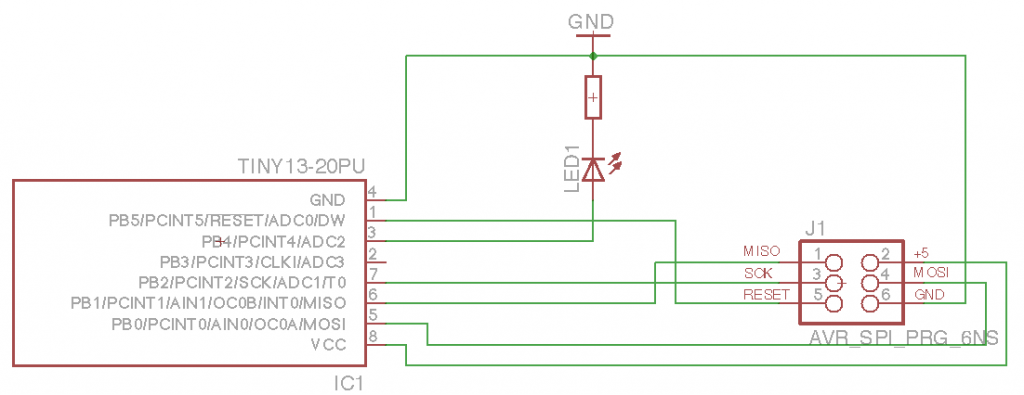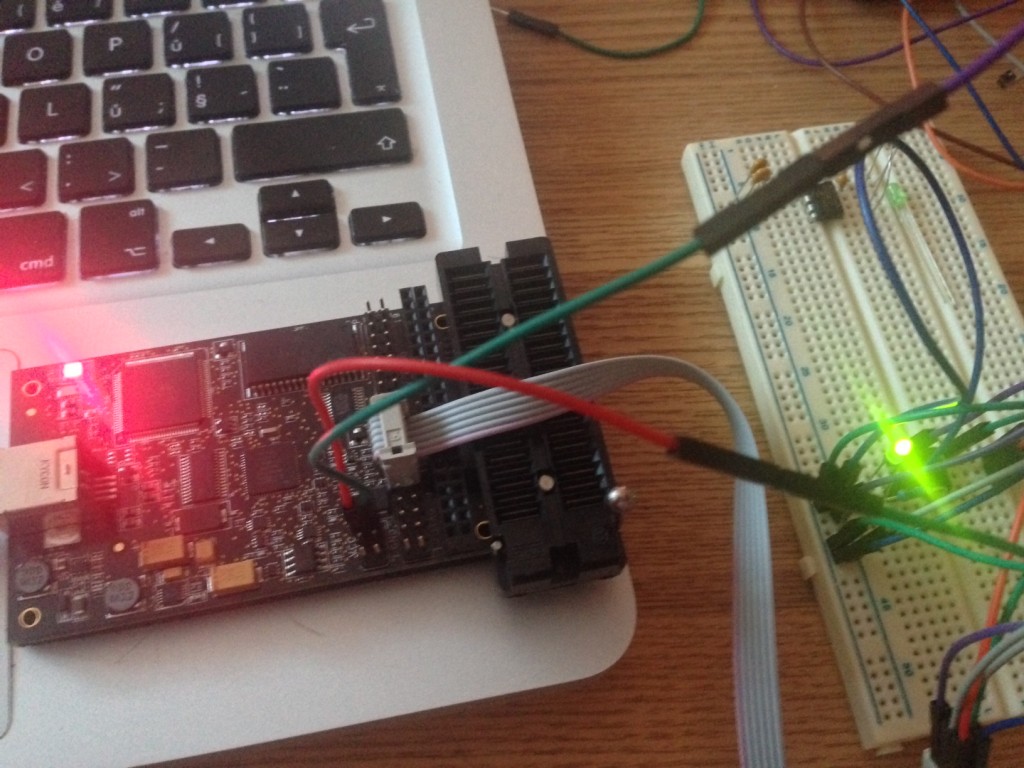Finally managed to get into AVR programming. Using OSX, which I found as the worst platform for doing any kind of embed programming :( Sad. Anyway, there’s my first ATtiny schematics and code. I’m using AVR Dragon to flash code into the MCU.
The circuit is quite simple. I just confirm SPI flashing works and I’m able to turn the LED on. So here’s some code (using avr-gcc to compile and avrdure to upload). Create new project using avr-project and add this to main.c file:
#include <avr/io.h>
#include <util/delay.h>
int main(void)
{
const int msDelay = 50;
// PortB pin4 to output (set bit to 1 using SHL)
DDRB = 1<<DDB4;
// PortB to low
PORTB = 0;
while (1) {
// XOR on pin 4
PORTB ^= 1<<PB4;
_delay_ms(msDelay);
}
return 0;
}
Now we can compile the firmware and upload to our MCU.
$ make avr-gcc -Wall -Os -DF_CPU=8000000 -mmcu=attiny13 -c main.c -o main.o avr-gcc -Wall -Os -DF_CPU=8000000 -mmcu=attiny13 -o main.elf main.o rm -f main.hex avr-objcopy -j .text -j .data -O ihex main.elf main.hex avr-size --format=avr --mcu=attiny13 main.elf AVR Memory Usage ---------------- Device: attiny13 Program: 72 bytes (7.0% Full) (.text + .data + .bootloader) Data: 0 bytes (0.0% Full) (.data + .bss + .noinit)
No errors. Great. Connect AVR Dragon and upload our new firmware:
$ make flash
avrdude -c dragon_isp -P usb -p attiny13 -U flash:w:main.hex:i
avrdude: AVR device initialized and ready to accept instructions
Reading | ################################################## | 100% 0.15s
avrdude: Device signature = 0x1e9007
avrdude: NOTE: "flash" memory has been specified, an erase cycle will be performed
To disable this feature, specify the -D option.
avrdude: erasing chip
avrdude: reading input file "main.hex"
avrdude: writing flash (110 bytes):
Writing | ################################################## | 100% 0.46s
avrdude: 110 bytes of flash written
avrdude: verifying flash memory against main.hex:
avrdude: load data flash data from input file main.hex:
avrdude: input file main.hex contains 110 bytes
avrdude: reading on-chip flash data:
Reading | ################################################## | 100% 0.47s
avrdude: verifying ...
avrdude: 110 bytes of flash verified
avrdude: safemode: Fuses OK (H:FF, E:FF, L:6A)
avrdude done. Thank you.
For those, interested in .hex file – this is how it looks like:
$ cat main.hex :1000000009C00EC00DC00CC00BC00AC009C008C09A :1000100007C006C011241FBECFE9CDBF02D012C059 :10002000EFCF80E187BB18BA90E188B3892788BBFE :100030002FE738E381E0215030408040E1F700C0F5 :080040000000F3CFF894FFCF9C :00000001FF
and I made some commented assembler output (base is taken from avr-objdump -S main.elf).
cat main.S main.elf: file format elf32-avr Disassembly of section .text: 00000000 <__vectors>: 0: 09 c0 rjmp .+18 ; 0x14 <__ctors_end> 2: 0e c0 rjmp .+28 ; 0x20 <__bad_interrupt> 4: 0d c0 rjmp .+26 ; 0x20 <__bad_interrupt> 6: 0c c0 rjmp .+24 ; 0x20 <__bad_interrupt> 8: 0b c0 rjmp .+22 ; 0x20 <__bad_interrupt> a: 0a c0 rjmp .+20 ; 0x20 <__bad_interrupt> c: 09 c0 rjmp .+18 ; 0x20 <__bad_interrupt> e: 08 c0 rjmp .+16 ; 0x20 <__bad_interrupt> 10: 07 c0 rjmp .+14 ; 0x20 <__bad_interrupt> 12: 06 c0 rjmp .+12 ; 0x20 <__bad_interrupt> 00000014 <__ctors_end>: ; set stack to SRAM 14: 11 24 eor r1, r1 ; set 0 to r1 16: 1f be out 0x3f, r1 ; 0 -> SPH 18: cf e9 ldi r28, 0x9F ; RAMEND 1a: cd bf out 0x3d, r28 ; r28 -> SPL 1c: 02 d0 rcall .+4 ; call main loop at 0x22 1e: 12 c0 rjmp .+36 ; then call exit at 0x44 00000020 <__bad_interrupt>: 20: ef cf rjmp .-34 ; 0x0 <__vectors> 00000022 <main>: 22: 80 e1 ldi r24, 0x10 ; 1<<DDB4 (0x10) -> r24 24: 87 bb out 0x17, r24 ; set r24 -> DDRB 26: 18 ba out 0x18, r1 ; set r1 (0) -> PORTB 28: 90 e1 ldi r25, 0x10 ; 1<<DDB4 2a: 88 b3 in r24, 0x18 ; read PORTB -> r24 to XOR 2c: 89 27 eor r24, r25 ; XOR pin 4 2e: 88 bb out 0x18, r24 ; set r24 -> PORTB 30: 2f e7 ldi r18, 0x7F ; 0x01387f = wait 79999 ticks (50ms at 4MHz) 32: 38 e3 ldi r19, 0x38 ; 34: 81 e0 ldi r24, 0x01 ; 36: 21 50 subi r18, 0x01 ; decrease r18 by 1 38: 30 40 sbci r19, 0x00 ; and decrease other by carry bit 3a: 80 40 sbci r24, 0x00 ; 3c: e1 f7 brne .-8 ; repeat until zero set - jump to 0x36 3e: 00 c0 rjmp .+0 ; relative jump to 0x40 40: 00 00 nop ; do nothing 42: f3 cf rjmp .-26 ; jump back to 0x2a (loop) 00000044 <_exit>: 44: f8 94 cli 00000046 <__stop_program>: 46: ff cf rjmp .-2 ; 0x46 <__stop_program>

